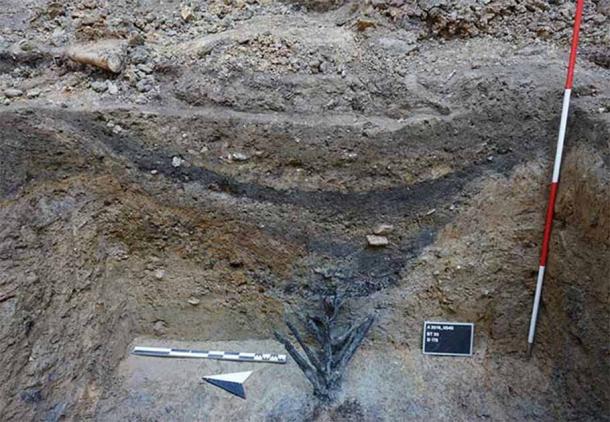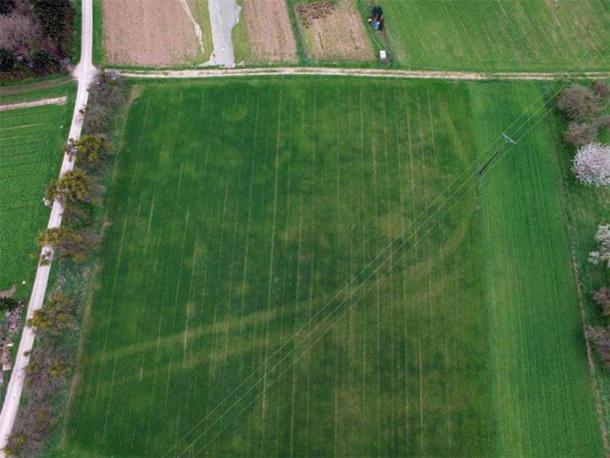Caesar’s Savage Human Skewers Unearthed In German Fort
Was this German silver mine really defended by two Roman forts and a line of “spike defenses”? Or, were the Romans protecting something even more valuable than silver?
Having spent several months in the French hills fighting off clandestine guerrilla attacks, Roman emperor Julius Caesar was utterly exhausted. In his book ” Gallic Wars ,” Cesar described his invention of a horrific weapon of war: rows of submerged “spiked” tree branch fortifications.
Once the Roman soldiers had cut and sharpened hundreds of thick tree branches, they were sunk into trenches and covered with branches, to hide them. Caesar noted that whoever attempted to enter his camp would “impale themselves on very sharp stakes.”
Having secured his HQ, Caesar strategized for the 52 BC Battle of Alesia, in which battled and crushed the largest Gallic army ever assembled, under the command of general Vercingetorix.
Now, more than two millennia later, archaeologists over in Germany have discovered similar “defensive stakes” to what Caesar described, that are ‘believed’ to have protected an ancient silver mine.

The excavation site that revealed the first example of the Roman defensive spikes. (Frederic Auth/ Aktuelles Uni )
If You Attack By Night, You Get Skewered. Simple
A report about this recent discovery of “stake defenses” in Live Science describes the system as “ancient barbed wire.” This description is accurate only in that the sharpened branches served to deter people entering a location, but in reality, this system of defense was nothing like barbed wire. While warriors might get entangled in barbed wire, and subsequently arrowed or chopped up, lines of closely positioned sharp wooden stakes would have pierced Gallic and Germanic soldiers’ bodies like kebab skewers.
The discovery site was at Bad Ems, which is about halfway between the present-day cities of Bonn and Mainz in Germany. The site was first explored by professional archaeologists from the late 19th century, however, the recent discovery of an ancient Roman ‘spike defense’ was made by a team of students. And to put this find into proper context, this area of Germany was known as “the limes” (meaning “boundary line”), and served as the northern border of the Roman Empire.

The excavations in Bad Ems were initiated by J. Eigenbrod, who spotted suspicious traces in the field which were the first sighting of a Roman ditch. (Hans-Joachim du Roi/ Aktuelles Uni )
Roman Military Power Rising
During the late 19th century excavations, archaeologists at this site identified wall foundations, processed silver ore and metal slag. This led to the assumption that the site was a smelting works dating to the early second century AD. But in 2016, a researcher noticed a series of unnaturally square crop formations and informed archaeologists at the Goethe University in Frankfurt.
Trying to contextualize the crop marks, archaeologists researched volumes of ancient literature and were recently able to pinpoint an ancient “ Roman fort .” The following excavations were led by Professor Markus Scholz, from Goethe University, and after test trenches were dug a “20-acre (8 hectares) double-ditched Roman camp with the remains of around 40 wooden watchtowers” was discovered.
Thanks Only To Damp Conditions
The preserved wooden spikes were found in damp soil on Blöskopf Hill. At this site, which is about 2 kilometers (1.3 miles) distant from the first fort, a second Roman fort was recently discovered. The team of excavators found a Roman coin that was minted in 43 AD, which established that the two forts were built before The Limes defenses, that were constructed in 110 AD.
The researchers said it was the particularly damp condition of the soil on Blöskopf Hill that preserved the ancient wooden stakes, which would otherwise have deteriorated long ago. While scouring through historical records the archaeologists read the works of the Roman historian, Tacitus, who wrote that a Roman governor named Curtius Rufus had failed trying “to mine silver” in this area of Germany in 47 AD.
While Rufus came away empty handed, this was no failing of his geographers and geologists, for in the preceding centuries around 200 tons of silver was mined from the site, according to Live Science. The Roman digging technologies simply couldn’t dig deep enough to hit the pay dirt.
All Might Not Be What It Seems
In ancient Rome, the arts of war were taught based on previous successful military campaigns. While Julius Caesar died over half a century before the two forts were built at Bad Ems in Germany, it certainly ‘appears’ that the great military leader’s brutal spikes, that he designed under duress in France, were recreated by later Roman generals in Germany to guard what they considered as a potentially valuable silver mine.
While the stake defense discovered in Germany ‘suggests’ Caesar’s battle tactics were reused in Germany long after he died, archaeologist Markus Scholz is showing caution regarding the whole discovery. He says there exists a lot of outstanding questions, for example, why was the larger of the two forts never completed? Furthermore, why were both forts purposefully burned shortly after their construction?
Until answers to these questions are found, the idea that the two Roman forts were built to defend a silver mine is pure speculation. And so too is the notion that the spiked branches also guarded that same mine. It might be the case that something else was being guarded, or defended, that potentially impales the mine into historical insignificance. However, Scholz is confident that all these questions will soon be answered after the next round of digs at the location.
Related Post
A shocking documentary proves that mermaids do exist
SHOCKING Revelation: Thuya, Mother of Queen Tiye, Was the Grandmother of Akhenaten and Tutankhamun—What Ancient Egyptian Secrets Did She Leave Behind?
Breaking News: Astonishing Discoveries at Karahan Tepe Confirm an Extraterrestrial Civilization is Hiding on Earth, and NO ONE Knows!
Breaking News: Researchers FINALLY Discover U.S. Navy Flight 19 After 75 Years Lost in the Bermuda Triangle!
NASA’s Secret Investigation: Uncovering the Astonishing Mystery of the UFO Crash on the Mountain!
Explosive UFO Docs LEAKED: Startling Proof That Aliens Ruled Ancient Egypt!